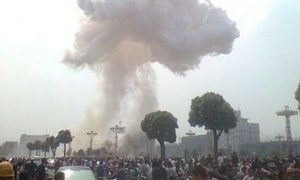Memo #89
By Paul Bowles – paul [at] unbc.ca
 Two weeks ago three bombs went off at government offices in Jiangxi province. They were set by a farmer angered about his house being demolished. Local disputes remain common, especially over land. Inflation, particularly rising food prices, has raised social tensions and have sparked further protests. The leadership remains nervous.
Two weeks ago three bombs went off at government offices in Jiangxi province. They were set by a farmer angered about his house being demolished. Local disputes remain common, especially over land. Inflation, particularly rising food prices, has raised social tensions and have sparked further protests. The leadership remains nervous.
So how has Beijing tried to head off rural protests? For a decade now, China’s leaders have deliberately implemented policies intended to release and contain pressures in rural areas. Beijing is gambling that it can control the social tensions generated by 30 years of intensified market-led reforms. These reforms have improved the lives of many, but very unevenly.
The gamble is based on policies aimed to help those in the rural and urban sectors who are not sharing in China’s growth. In the rural sector, the top priority for the government from 2004 to 2006 was to increase the income of farmers. In each of these years the “Number 1″ policy document – which sets priorities for the year – outlined policies for rural areas.
These included the abolition of agricultural taxes (for the first time in China’s history) and the abolition of school charges and book fees to establish free compulsory rural schooling. They also included the introduction of a ‘rural health cooperative scheme’ and rural pension programs, as well as infrastructure projects aimed at the poorest areas. These projects were complemented by those announced in the stimulus package in the wake of the 2008 global financial crisis which also boosted spending in rural areas.
This concerted effort was needed to assist those in rural areas whose standard of living had been falling compared to those living in urban areas. The abolition of agricultural taxes and fees alone is estimated to have increased rural incomes by 15 per cent. Inequality within rural areas seems to have been reduced despite the increased marketization of the agricultural sector, following China’s WTO entry in 2002.
While the aggregate data point to some significant improvements in the well-being of the rural population, the continued local disputes over land and corruption mean that Beijing has not yet won its gamble. The protests will not end anytime soon.
About the Author:
Paul Bowles – Professor, Department of Economics, University of Northern British Columbia.
Links:
- Special Issue on Globalization(s) and Labour in China and India, Global Labour Journal, Volume 1, Issue 1 (See the work of Xiaoyuan Dong and Hongqing Chang)
- Three dead in Chinese bombings, Toronto Star, May 2011
- China unrest as hundreds protest against Taizhou ‘land grabs,’ the Guardian, June 2011
- Pictures of a rural protest in China
Related Memos:
- Our collection of Memos on the Origins of Social Protests in China
- Our other Memos about China
